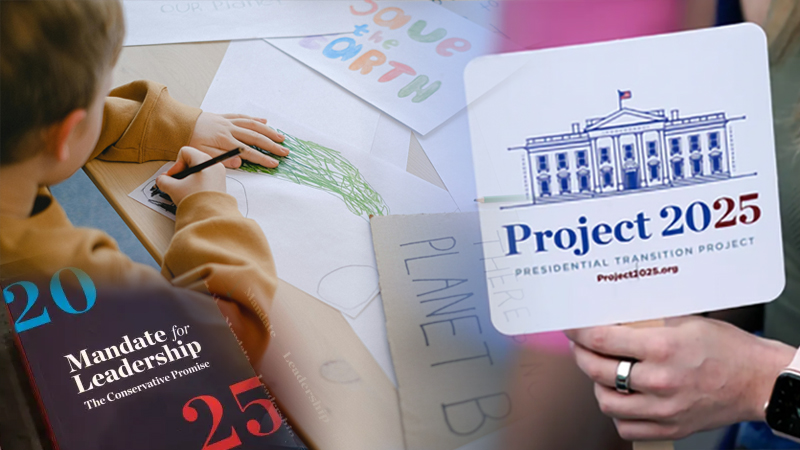This article is part of First Focus on Children’s analysis of Project 2025, the granular policy agenda intended to serve as the “playbook” for a Republican presidential administration. This extremist agenda, along with the Republican candidate’s own words and platform, proposes measures that would leave America’s children poorer, sicker, and less likely to become productive citizens. Our series explores some of the most harmful proposals.

Project 2025, the granular “playbook” assembled by the ultra-conservative Heritage Foundation for the next Republican administration, outlines a plan to gut environmental regulations and programs that currently protect underserved communities and, in particular, children.
In its attack on the U.S. Environmental Protection Agency (EPA), Project 2025 would reduce restrictions on pollutants, eliminate environmental justice programs, and consequently ignore children. Many of the proposals would put business before science and suggest replacing senior scientists with business-savvy executives or members of Congress regardless of their scientific background.
First Focus on Children has long advocated for environmental and climate policies that protect children and their right to a healthy future. Our goal is to advance environmental justice and ensure that children, whose developing brains and bodies are more susceptible to environmental contaminants, are appropriately accounted for in all decision making. Specifically, we have urged lawmakers to support legislation that protects children from pesticides and toxins, especially lead. We have supported laws and regulations that shield marginalized communities and invest in combatting climate change and its impact on children’s health.
Project 2025 directly and specifically attacks EPA’s environmental justice mission and programs. For decades, industry giants have intentionally targeted low-income communities and communities of color — called “frontline” communities — for pollution and hazardous waste on the theory that their lack of resources would make them less likely to resist new power plants, landfills, waste dumping, and other hazards. Children in these communities routinely report higher instances of asthma, lead poisoning, and obesity, all health issues linked to environmental injustice. Project 2025 would gut the regulations and programs aimed at protecting these communities.
Children are uniquely vulnerable to pollutants and therefore especially sensitive to environmental injustice. They drink more water, eat more food, and breathe more air in relation to their body weight than adults. They also routinely put their hands in their mouths and play outside, increasing their chances of exposure. The damage resulting from exposure to pollutants can also include neurodevelopmental issues and other complications that can follow them for a lifetime.
EPA’s Environmental Justice programs aim to mitigate this damage by directing funds to frontline communities. Many of these programs provide grants directly to communities and non-profits working on the ground to clean up abandoned pollution sites (known as brownfields), reduce pollution in local waterways, cut back emissions and protect the air, land, and water in these communities.
Specifically, Project 2025 would:
Eliminate the Office of Environmental Justice and External Civil Rights (OEJECR)
Project 2025 makes destroying EPA’s Environmental Justice programs one of its top priorities. The Biden Administration created OEJECR in 2022 to advance environmental justice and enforce civil rights laws in communities that the agency historically has overlooked. The office has been instrumental in providing technical support and implementing the $3 billion in climate and environmental justice block grants provided by the Inflation Reduction Act, which have directly supported states, tribes, municipalities, and community-based organizations in their work to create healthier communities. The office also works to incorporate environmental justice into each sector of EPA’s work, ensuring that programs and rules specifically uplift and protect frontline communities. Eliminating this office means that EPA will struggle to meaningfully prioritize environmental justice.
Eliminate the Office of Children’s Health Protection (OCHP)
Project 2025 would disband the stand-alone Office of Children’s Health Protection (OCHP) and redistribute its functions across the agency. OCHP specifically focuses on the impact that rules, policies, research, and enforcement have on children’s environmental health. This move would ensure that no single office is working to protect children, diluting — and likely dissolving altogether — the agency’s awareness of and focus on children’s health.
Eliminating Race from Consideration in the programs that remain
Racial disparities, especially among children, are one of the key drivers of environmental health inequities. Communities of color have historically been targeted as areas for releasing pollution and waste, as companies knew that the government was less likely to protect them. After the Administration eliminates OEJECR, Project 2025 suggests that any environmental justice initiatives remaining in EPA’s other programs should not consider race when making decisions. The proposal cites the seemingly unrelated Students for Fair Admissions v. University of North Carolina Supreme Court case, decided earlier this year, as grounds for a race-neutral approach to distributing environmental justice funds. The Court found that UNC violated the 14th Amendment by considering race in their admissions process. Project 2025 now claims that considering race in the distribution of environmental justice funds could do the same. Yet, race has been one of the key determinants in environmental injustice. Failure to consider it when correcting these issues will only create deeper inequities for children of color.
First Focus on Children remains dedicated to advancing environmental justice for all children. The environments our children learn, grow, and play in shape their health for a lifetime. An equity-based approach to tackling environmental and climate pollution is critical to ensure children who have been left behind for decades get a chance at a healthy and fulfilling life. The next administration can and should protect our children by protecting their land, air, and water.
